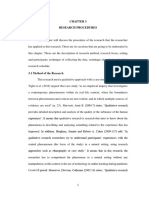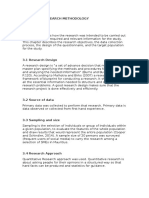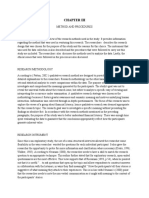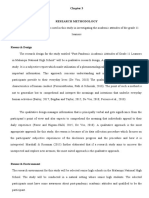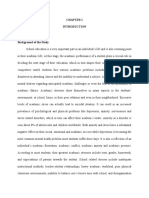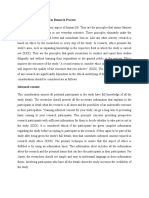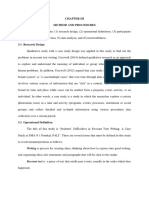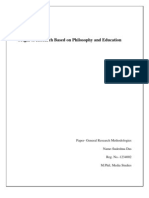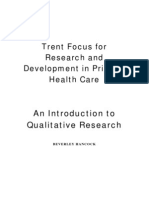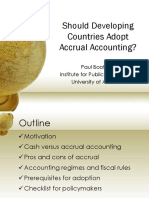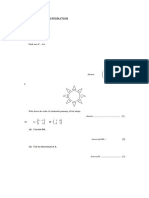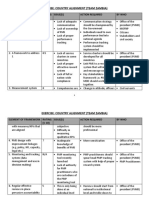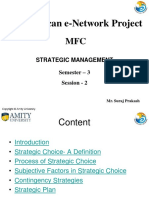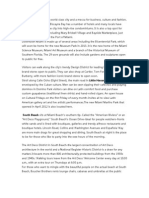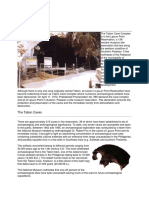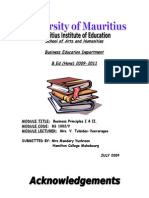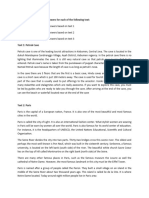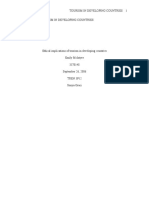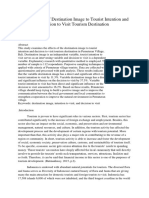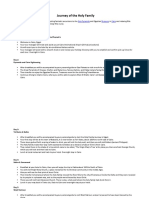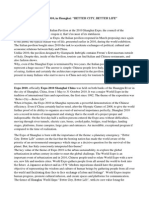Chapter 3
Chapter 3
Uploaded by
Mr DamphaCopyright:
Available Formats
Chapter 3
Chapter 3
Uploaded by
Mr DamphaOriginal Description:
Original Title
Copyright
Available Formats
Share this document
Did you find this document useful?
Is this content inappropriate?
Copyright:
Available Formats
Chapter 3
Chapter 3
Uploaded by
Mr DamphaCopyright:
Available Formats
CHAPTER 3: RESEARCH METHODOLOGY
3.1 Introduction
As it is indicated in the title, this chapter includes the research methodology of
the dissertation. In more details, in this part the author outlines the research
strategy, the research method, the research approach, the methods of data
collection, the selection of the sample, the research process, the type of data
analysis, the ethical considerations and the research limitations of the project.
3.2 Research strategy
The research held with respect to this dissertation was an applied one, but not
new. Rather, numerous pieces of previous academic research exist regarding
the role of DMOs in promoting and managing tourist destinations, not only for
Athens in specific, but also for other tourist destinations in Greece and other
places of the world. As such, the proposed research took the form of a new
research but on an existing research subject.
3.3 Research method – Qualitative versus Quantitative
techniques
In order to satisfy the objectives of the dissertation, a qualitative research was
held. The main characteristic of qualitative research is that it is mostly
appropriate for small samples, while its outcomes are not measurable and
quantifiable (see table 3.1). Its basic advantage, which also constitutes its
basic difference with quantitative research, is that it offers a complete
description and analysis of a research subject, without limiting the scope of
the research and the nature of participant’s responses (Collis & Hussey,
2003).
However, the effectiveness of qualitative research is heavily based on the
skills and abilities of researchers, while the outcomes may not be perceived
as reliable, because they mostly come from researcher’s personal judgments
and interpretations. Because it is more appropriate for small samples, it is
also risky for the results of qualitative research to be perceived as reflecting
the opinions of a wider population (Bell, 2005).
Qualitative research
Quantitative Research
The aim is a complete, detailed
description.
The aim is to classify features,
count them, and construct
statistical models in an attempt to
explain what is observed.
Researcher may only know roughly in
advance what he/she is looking for.
Researcher knows clearly in
advance what he/she is looking for.
Recommended during earlier phases of
research projects.
Recommended during latter
phases of research projects.
The design emerges as the study
unfolds.
All aspects of the study are
carefully designed before data is
collected.
Researcher is the data gathering
instrument.
Researcher uses tools, such as
questionnaires or equipment to
collect numerical data.
Data is in the form of words, pictures or
objects.
Data is in the form of numbers and
statistics.
Subjective – individuals interpretation
of events is important ,e.g., uses
participant observation, in-depth
interviews etc.
Objective: seeks precise
measurement & analysis of target
concepts, e.g., uses surveys,
questionnaires etc.
Qualitative data is more 'rich', time
consuming, and less able to be
generalized.
Quantitative data is more efficient,
able to test hypotheses, but may
miss contextual detail.
Researcher tends to become
subjectively immersed in the subject
matter.
Researcher tends to remain
objectively separated from the
subject matter.
Adapted from: Miles & Huberman (1994, p. 40). Qualitative Data Analysis, available
at http://wilderdom.com/research/QualitativeVersusQuantitativeResearch.html
Table 3.1: Features of Qualitative & Quantitative Research
3.4 Research approach
The research approach that was followed for the purposes of this research
was the inductive one. According to this approach, researchers begin with
specific observation, which are used to produce generalized theories and
conclusions drawn from the research. The reasons for occupying the inductive
approach was that it takes into account the context where research effort is
active, while it is also most appropriate for small samples that produce
qualitative data. However, the main weakness of the inductive approach is
that it produces generalized theories and conclusions based only on a small
number of observations, thereby the reliability of research results being under
question (Denzin & Lincoln, 2005).
3.5 Data collection method and tools
For the purposes of this research, in depth interviews were used.
In depth interviews are personal and unstructured interviews, whose aim is to
identify participant’s emotions, feelings, and opinions regarding a particular
research subject. The main advantage of personal interviews is that they
involve personal and direct contact between interviewers and interviewees, as
well as eliminate non-response rates, but interviewers need to have
developed the necessary skills to successfully carry an interview (Fisher,
2005, Wilson, 2003). What is more, unstructured interviews offer flexibility in
terms of the flow of the interview, thereby leaving room for the generation of
conclusions that were not initially meant to be derived regarding a research
subject. However, there is the risk that the interview may deviate from the pre-
specified research aims and objectives (Gill & Johnson, 2002).
As far as data collection tools were concerned, the conduction of the research
involved the use of semi-structured questionnaire, which was used as an
interview guide for the researcher. Some certain questions were prepared, so
as for the researcher to guide the interview towards the satisfaction of
research objectives, but additional questions were made encountered during
the interviews.
Some sample questions that were included in the semi-structured
questionnaire were the following:
Question 1: What do you think about the popularity of Greece as a tourist
destination?
Question 2: What do you think about the popularity of Athens as a tourist
destination?
Question 3: What have you done as an organization to promote Athens as a Tourist
destination? Were your activities efficient? (Please discuss)
Question 4: Do you think that Athens can become a more popular destination in the
near future? How it can enhance its brand name as a tourist destination?
Question 5: What are the main problems and Challenges of Athens as a Tourist
destination? What are the key advantages? What are these problems causing? Are
they affecting their activities for promoting Athens as a destination?
Question 6: What activities your organization applies for addressing the problems
that Athens faces as a tourist destination?
Question 7: In your view, which are the improvements that your organization should
made in order to increase its efficiency and for promoting tourism more effectively?
Question 8: What do you think about the role of Greek DMOs in promoting the
tourism in Greece? Do you have any recommendation for improvement?
Question 9: Do you have experience of DMOs in other countries? How they
operate? What can we learn from them?
Question 10: How do you manage the tourist product of Athens, except for
marketing? Do you pay attention to sustainable tourism issues? How do the city and
residents of Athens benefit from your management practices?
Question 11: Marketing and Destination Marketing can help Athens and Greece to
develop their touristic offer more efficiently? With what actions and programs?
(A detailed form of the interview guide is presented in Appendixes A)
3.6 Sample selection
The method of purposive sampling was used to develop the sample of the
research under discussion. According to this method, which belongs to the
category of non-probability sampling techniques, sample members are
selected on the basis of their knowledge, relationships and expertise
regarding a research subject (Freedman et al., 2007). In the current study, the
sample members who were selected had special relationship with the
phenomenon under investigation, sufficient and relevant work experience in
the field of tourism, active involvement in several tourism initiatives and
partnerships, as well as proven research background and understanding of
raw data concerning destinations. Within this context, the participants of this
study were executives of 6 famous DMOs operating both generally in Greece
and specifically in Athens, namely:
1) Greek National Tourism Organization (G.N.T.O)
2) City of Athens Convention and Visitors Bureau (ACVB)
3) Athens Development and Destination Management Agency (ADDMA)
4) Athens Hotel Association - Attica (EXAA)
5) Athens Chamber of Commerce and Industry (ICCI)
6) Association of Greek Tourism Enterprises (SETE)
3.7 Research process
Meetings were held during April and June of 2014 with the executives of the
DMOs mentioned above, so as to gain acceptance of their participation in the
research. More specifically, the researcher came in touch with and asked
them to participate in the research after explaining the nature and the scope
of the study. In general terms the respondents were willing to participate in the
research and the interviews were conducted between May and June of 2014.
The discussions took place at the offices of the executives and lasted
approximately 20 to 25 minutes. During the interviews were mainly kept notes,
in order to help the researcher to analyze the gathered data.
During the conduction of the interview, respondents were free to express their
views even in topics which were not included in the discussed areas which
were mentioned in paragraph 3.5. Finally, it should be noted that the
conversations flowed smoothly and pleasantly.
3.8. Data analysis
Content analysis was used to analyze the data which was gathered from
personal interviews. According to Moore & McCabe (2005), this is the type of
research whereby data gathered is categorized in themes and sub-themes, so
as to be able to be comparable. A main advantage of content analysis is that
it helps in data collected being reduced and simplified, while at the same time
producing results that may then measured using quantitative techniques.
Moreover, content analysis gives the ability to researchers to structure the
qualitative data collected in a way that satisfies the accomplishment of
research objectives. However, human error is highly involved in content
analysis, since there is the risk for researchers to misinterpret the data
gathered, thereby generating false and unreliable conclusions (Krippendorff &
Bock, 2008).
3.9 Ethical considerations
The current study was subject to certain ethical issues. As it was mentioned
earlier, all participants reported their written acceptance regarding their
participation in the research, through a signed Consent and Briefing Letter.
At the same time, sample members were asked to sign a Debriefing and
Withdrawal Letter. The aim of both letters was to reassure participants that
their participation in the research is voluntary and that they were free to
withdraw from it at any point and for any reason.
Next to this, participants were fully informed regarding the objectives of the
study, while they were reassured that their answers were treated as
confidential and used only for academic purposes and only for the purposes
of the particular research. Except from the above, participants were not
harmed or abused, both physically and psychologically, during the conduction
of the research. In contrast, the researcher attempted to create and maintain
a climate of comfort.
3.10 Research Limitations
As it is for every study, this dissertation had the following limitations:
The size of the sample was relatively small - 6 participants. A bigger
sample would probably enhance the reliability of the research
Qualitative research is not allowing the measurement of the examined
problems
The analysis of the role of the DMOs in the promotion of Athens as a
tourist destination may be influenced by factors which were not
mentioned in this project
In some cases participants may refused to speak against their
organizations
CitationsCitations1
References
CHAPTER 3 - RESEARCH METHODOLOGY: Data collection method and Research tools
(PDF Download Available). Available from:
https://www.researchgate.net/publication/270956555_CHAPTER_3_-
_RESEARCH_METHODOLOGY_Data_collection_method_and_Research_tools [accessed
Aug 29, 2017].
You might also like
- The Qualitative Research ProposalDocument11 pagesThe Qualitative Research Proposalanisatun nikmah0% (1)
- Public Procurement LectureDocument37 pagesPublic Procurement LectureMr DamphaNo ratings yet
- Case 4 Amadubi Rural Tourism Project ADocument14 pagesCase 4 Amadubi Rural Tourism Project ADani YustiardiNo ratings yet
- Primary Sources of Data and Secondary Sources of Data: September 2017Document6 pagesPrimary Sources of Data and Secondary Sources of Data: September 2017Tejaswini RoutNo ratings yet
- Research Methodology ChapterDocument5 pagesResearch Methodology ChapterBinayKPNo ratings yet
- Perceptions and Factors Influencing StudDocument11 pagesPerceptions and Factors Influencing StudJaela PulmanoNo ratings yet
- Agritourism StudyDocument201 pagesAgritourism StudyRosejaneLim0% (1)
- Chapter 3Document10 pagesChapter 3Nindya AhmadNo ratings yet
- Problems Encountered by Police Personnel in Conducting DrugDocument5 pagesProblems Encountered by Police Personnel in Conducting DrugRanie MonteclaroNo ratings yet
- Chapter 3Document3 pagesChapter 3Fish de PaieNo ratings yet
- Chapter IiiDocument3 pagesChapter Iiikaycel ramosNo ratings yet
- Chap 1-3 (Part 1)Document22 pagesChap 1-3 (Part 1)Jerine BenedictoNo ratings yet
- Establishing-Trustworthiness-of-Data 2Document2 pagesEstablishing-Trustworthiness-of-Data 2Adine Jeminah LimonNo ratings yet
- CHAPTER-3Document7 pagesCHAPTER-3Kael ZenNo ratings yet
- Research GapDocument1 pageResearch GapJohn Patrick MolinaNo ratings yet
- A Conceptual Framework of The Evolution of School PsychologyDocument17 pagesA Conceptual Framework of The Evolution of School PsychologyFernandoNo ratings yet
- Chapter 3 Research Design and Methodology 3.1. IntroductionDocument14 pagesChapter 3 Research Design and Methodology 3.1. IntroductionBright MachawiraNo ratings yet
- FMR - Thesis - Group 5 (Final)Document26 pagesFMR - Thesis - Group 5 (Final)Queen ZaportizaNo ratings yet
- 03chapter3 PDFDocument37 pages03chapter3 PDFazitaNo ratings yet
- FLCTP - Module 1-2Document13 pagesFLCTP - Module 1-2Stella Mariz GalauraNo ratings yet
- Final ResearchDocument39 pagesFinal ResearchBhoxzs Brandon UmbacNo ratings yet
- Chapter Three: Research MethodologyDocument20 pagesChapter Three: Research MethodologyRogerKYChan100% (1)
- CHAPTER 3 GROUP 2 CDocument7 pagesCHAPTER 3 GROUP 2 CYin ObispoNo ratings yet
- Case Study Research DesignDocument4 pagesCase Study Research Designnafi annuryNo ratings yet
- ResearchDocument13 pagesResearchMarion Joy GanayoNo ratings yet
- Ethical ConsiderationsDocument3 pagesEthical ConsiderationsJen NishNo ratings yet
- Questionnaire ConstructionDocument5 pagesQuestionnaire Constructionsujitsdm88No ratings yet
- Sampling Qualitative ResearchDocument11 pagesSampling Qualitative ResearchJoyce Anne Valladolid100% (4)
- Chapter IIIDocument4 pagesChapter IIIYutaka putriNo ratings yet
- Practices and Effects of Child Abuse On Learner's Academic Performance in Primary Schools (WWW - Kiu.ac - Ug)Document8 pagesPractices and Effects of Child Abuse On Learner's Academic Performance in Primary Schools (WWW - Kiu.ac - Ug)publication1No ratings yet
- Education A Unique Socializing AgentDocument38 pagesEducation A Unique Socializing AgentMarjorie Dequin100% (1)
- The Research PaperDocument2 pagesThe Research PaperAirah SantiagoNo ratings yet
- What Is ResearchDocument28 pagesWhat Is ResearchPeter WaterNo ratings yet
- Research Paper ProposalDocument45 pagesResearch Paper ProposalKacy KatNo ratings yet
- Practical Research 2: Schools Division of Bohol: 4: 7: 7Document2 pagesPractical Research 2: Schools Division of Bohol: 4: 7: 7Jown Honenew Lpt0% (1)
- Quantitative and Qualitative ResearchDocument30 pagesQuantitative and Qualitative ResearchJessaNo ratings yet
- Chapter 1 5Document66 pagesChapter 1 5Jennylyn BraceroNo ratings yet
- Research ParadigmDocument3 pagesResearch ParadigmHeri Zweer-Veetotz Durahman BackstabbersNo ratings yet
- Data Collection Methods and Tools For ResearchDocument30 pagesData Collection Methods and Tools For ResearchSausan Hidayah NovaNo ratings yet
- Origin of Research Based On PhilosophyDocument6 pagesOrigin of Research Based On Philosophysudeshna86100% (1)
- Chapter 3 - Understanding Research EthicsDocument16 pagesChapter 3 - Understanding Research Ethicsniaz kilamNo ratings yet
- Chapter 3Document5 pagesChapter 3Carl Justine S. CatalanNo ratings yet
- QuestionareDocument9 pagesQuestionareJhon Devon LargoNo ratings yet
- Qualitative ResearchDocument31 pagesQualitative Researchrimuly100% (5)
- The Research PaperDocument40 pagesThe Research PaperJoy Dimaculangan-Moreno100% (1)
- Relationship Between Parental Socioeconomic Conditions and Students Academic Achievements A Case of District Dir Timergara PakistanDocument6 pagesRelationship Between Parental Socioeconomic Conditions and Students Academic Achievements A Case of District Dir Timergara PakistankiranNo ratings yet
- Chapter 3Document13 pagesChapter 3Radiah MassytohNo ratings yet
- Influence of Inquiry-Based Science Activities On Students' AchievementDocument14 pagesInfluence of Inquiry-Based Science Activities On Students' AchievementPsychology and Education: A Multidisciplinary Journal100% (2)
- Characteristics of Qualitative ResearchDocument7 pagesCharacteristics of Qualitative ResearchDodong Pantinople100% (1)
- Scope and DelimitationDocument8 pagesScope and DelimitationEmie Lyn Rose AgpaloNo ratings yet
- Letter of Consent For PartticipantsDocument1 pageLetter of Consent For PartticipantsAiraMagalonaAguilarNo ratings yet
- A Quantitative Correlational Study Between Transformational LeadeDocument177 pagesA Quantitative Correlational Study Between Transformational LeadePrincess Camille RamosNo ratings yet
- Research Consent FormDocument3 pagesResearch Consent FormGenesis Sheldon LazoNo ratings yet
- Research Strategy A Complete Guide - 2020 EditionFrom EverandResearch Strategy A Complete Guide - 2020 EditionRating: 5 out of 5 stars5/5 (1)
- The Impact of a Deadly Pandemic on Individual, Society, Economy and the WorldFrom EverandThe Impact of a Deadly Pandemic on Individual, Society, Economy and the WorldNo ratings yet
- Chapter 3Document36 pagesChapter 3Max SalmorinNo ratings yet
- CHAPTER 3 - RESEARCH METHODOLOGY Data Co PDFDocument9 pagesCHAPTER 3 - RESEARCH METHODOLOGY Data Co PDFKassandra EbolNo ratings yet
- CHAPTER3-RESEARCHMETHODOLOGY DatacollectionmethodandResearchtools PDFDocument10 pagesCHAPTER3-RESEARCHMETHODOLOGY DatacollectionmethodandResearchtools PDFlapNo ratings yet
- Chapter 3 - Research Methodology: Data Collection Method and Research ToolsDocument10 pagesChapter 3 - Research Methodology: Data Collection Method and Research ToolslapNo ratings yet
- M.SC in Marketing ManagementDocument9 pagesM.SC in Marketing ManagementajhsdfNo ratings yet
- 9.4 Evaluating A Methodology With Questions (Worksheet 4) - Develop - ExampleDocument7 pages9.4 Evaluating A Methodology With Questions (Worksheet 4) - Develop - Example詹博智No ratings yet
- CHAPTER3-RESEARCHMETHODOLOGY DatacollectionmethodandResearchtools PDFDocument10 pagesCHAPTER3-RESEARCHMETHODOLOGY DatacollectionmethodandResearchtools PDFAhmad DanielNo ratings yet
- Seminar Presentation 2007 Boothe Capable Finance Ministries Strengthening Budget Offices English 7. Day 2 Session 3 MR BootheDocument20 pagesSeminar Presentation 2007 Boothe Capable Finance Ministries Strengthening Budget Offices English 7. Day 2 Session 3 MR BootheMr DamphaNo ratings yet
- SBPA Training Advert 1Document2 pagesSBPA Training Advert 1Mr DamphaNo ratings yet
- Budgeting and Budgetary Control PDFDocument39 pagesBudgeting and Budgetary Control PDFMr DamphaNo ratings yet
- UTG Training Flyer Dampha FannehDocument1 pageUTG Training Flyer Dampha FannehMr DamphaNo ratings yet
- Financial Statements in The Public Sector PDFDocument15 pagesFinancial Statements in The Public Sector PDFMr Dampha100% (1)
- Mensuration Geometry p24Document43 pagesMensuration Geometry p24Mr DamphaNo ratings yet
- Proportion and FunctionsDocument13 pagesProportion and FunctionsMr DamphaNo ratings yet
- Matrices and Transformation Paper 2 4Document26 pagesMatrices and Transformation Paper 2 4Mr DamphaNo ratings yet
- Target Costing Presentation FinalDocument57 pagesTarget Costing Presentation FinalMr Dampha100% (1)
- Project GuideDocument22 pagesProject GuideMr DamphaNo ratings yet
- The Gambia: October, 2016Document55 pagesThe Gambia: October, 2016Mr DamphaNo ratings yet
- ERNWACA-Gambia Quality 2003Document39 pagesERNWACA-Gambia Quality 2003Mr DamphaNo ratings yet
- International Finance & Forex Management 1Document102 pagesInternational Finance & Forex Management 1Mr DamphaNo ratings yet
- Gbmaa UpdatedDocument35 pagesGbmaa UpdatedMr DamphaNo ratings yet
- Strategic Management 3Document82 pagesStrategic Management 3Mr DamphaNo ratings yet
- Country Alignment Exercise 2Document3 pagesCountry Alignment Exercise 2Mr DamphaNo ratings yet
- Strategic Management 2Document92 pagesStrategic Management 2Mr DamphaNo ratings yet
- The Continuum From Harmony To WarDocument4 pagesThe Continuum From Harmony To WarMr DamphaNo ratings yet
- 04 FTEHandicraftsDocument61 pages04 FTEHandicraftsVijay ThubeNo ratings yet
- List of Airport Lounges PTCDocument5 pagesList of Airport Lounges PTCSushil DhillonNo ratings yet
- Module 3 Answer RABAGODocument4 pagesModule 3 Answer RABAGOClerk Janly R FacunlaNo ratings yet
- Soal PAS Ganjil Kelas X 2017Document7 pagesSoal PAS Ganjil Kelas X 2017Supri YantoNo ratings yet
- Comparatives 1 PDFDocument6 pagesComparatives 1 PDFSebastian OtaloraNo ratings yet
- Tugas Remedial BingDocument5 pagesTugas Remedial BingLysanmiNo ratings yet
- Mexico PresentationDocument19 pagesMexico PresentationCristian MacdonelNo ratings yet
- Sust Tour 2Document12 pagesSust Tour 2dattavi98thakerNo ratings yet
- Downtown Miami Is A WorldDocument5 pagesDowntown Miami Is A WorldAmy PangNo ratings yet
- Famous Tourist DestinationDocument15 pagesFamous Tourist Destination6666666666666-434137No ratings yet
- Tabon Cave ComplexDocument2 pagesTabon Cave ComplexFatima OguimasNo ratings yet
- Agro Tourism ProjectDocument20 pagesAgro Tourism ProjectsekarkkNo ratings yet
- Ecotourism in CityDocument6 pagesEcotourism in Cityxi wuNo ratings yet
- Business Principles AssignDocument5 pagesBusiness Principles AssignYushreen JambocusNo ratings yet
- Descriptive TextDocument2 pagesDescriptive TextdolppowNo ratings yet
- Soal Sumatif Tengah Semester Genap Bahasa Inggris Kelas Xi Kurikulum MerdekaDocument7 pagesSoal Sumatif Tengah Semester Genap Bahasa Inggris Kelas Xi Kurikulum Merdekaroihanmusic08No ratings yet
- Sustainable Tourism Short EssayDocument9 pagesSustainable Tourism Short EssayRohana FernandoNo ratings yet
- Word FormDocument1 pageWord Formalexandrakim0809No ratings yet
- The Influence of Destination Image To Tourist Intention and Decision To Visit Tourism DestinationDocument12 pagesThe Influence of Destination Image To Tourist Intention and Decision To Visit Tourism Destinationugdrsud mampangNo ratings yet
- Gastown, VancouverDocument20 pagesGastown, VancouverSunny GoyalNo ratings yet
- Coping With SeasonalityDocument10 pagesCoping With SeasonalityFrey Den Calzadora RodioNo ratings yet
- Journey of The Holy FamilyDocument6 pagesJourney of The Holy FamilyAl-Zahraa AwadNo ratings yet
- Manay Vs Cebu PacificDocument11 pagesManay Vs Cebu PacificGinn EstNo ratings yet
- Name: Shellamae Casol Sega Descriptive Essay About MindanaoDocument1 pageName: Shellamae Casol Sega Descriptive Essay About MindanaoShellamae Sega25% (4)
- Profile MT IsarogDocument2 pagesProfile MT IsarogAnwrdn Macaraig100% (2)
- Tourism PromotionDocument4 pagesTourism PromotionCherry Ann Mojares100% (1)
- Tourism Policy in KenyaDocument103 pagesTourism Policy in Kenyawangaicyrus29No ratings yet
- Expo 2010 in ShanghaiDocument3 pagesExpo 2010 in ShanghaiFedericoPalumeriNo ratings yet







